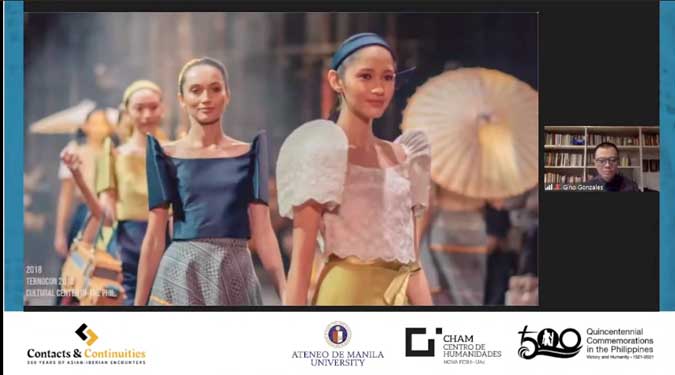A PANEL discussion on fashion emphasized the connections made by the colonial trading routes that connected the Philippines to the rest of the world.
“Contacts and Continuities: 500 Years of Asian-Iberian Encounters” is an international conference series organized by the CHAM–NOVA FCSH, (the Centro de Humanidades of the Faculdade de Ciencias Sociais e Humanas, of the Universidade Nova de Lisboa, Portugal), the National Quinticentennial Commitee, and hosted by the Ateneo de Manila University. A panel discussion — streamed on July 21 via YouTube — focused on fashion (the talks ran from June 21 to July 23, covering all sorts of topics, from language to literature, and the visual arts).
The various lectures and panels of “Contacts and Continuities: 500 Years of Asian-Iberian Encounters” can be seen at https://www.youtube.com/channel/UCtNy-Va7Elq3ixbp6uuxyBA.
LACE AND RELIQUARIES
Sandra Castro, an independent researcher and curator from New York, gave a talk titled “Hybridity and Identity in Philippine Colonial Whitework.” Here, she showed examples of whitework (defined as white needlework, usually decorative, on white fabric as a background), executed in the Philippines, and how it compared to similar examples from the rest of the world. Comparisons were made to muslin from India, which shared the same delicate, white, and translucent qualities as our native pina fabric.
According to her, whitework was formally introduced to the country in the 17th century through convent schools, and by the late 1800s, Manila had a booming industry in embroidered whitework, including that produced in the Asilo de San Vicente de Paul (an orphanage cum convent school; one alumna was the mother of Imelda Marcos).
She also shows examples of how Philippine techniques were used to copy European luxuries: Valenciennes lace — first done by hand then machine-made by twisting threads together — had a near copy in the Philippines where a textile was embroidered, and surrounding threads plucked out around the embroidery to show off the pattern.
Meanwhile, Dr. Florina Capistrano-Baker talked about the evolution of jewelry from before and after the period of colonization. She discussed the various found artifacts in the Philippines and surrounding Southeast Asia, executed in precious metals like gold and silver, and precious stones like jade. These evolved into the reliquarios (reliquaries) and other religious items worn later by wealthy colonized Filipinos.
TALKING TERNO
Author and acclaimed costume designer Gino Gonzales talked about the terno, and how it evolved from precolonial dress. He starts by defining the terno using online resources such as Google searches, illustrating that in Spanish, the word “terno” could either mean a suit, or a set of three things of the same kind (this foreshadows a later aspect).
Precolonial people once wore the baro (a heavily decorated top) and a tapis (a rectangular fabric worn as a skirt or apron), sometimes accompanied by a malong (a tube-shaped garment worn either on the top or the bottom). This evolved into the kamisa, a blouse which was often transparent. For women, a triangular fichu — now known as the panuelo — obscured the chest. The fichu is also present in European fashions of the 1700s. The panuelo was embroidered with local, Chinese, and Western motifs, and was emphasized in the whole outfit as it was the outermost and most visible garment. This whole set — the panuelo, the kamisa, and a skirt — came to be known as the traje de mestiza.
The outfits came to follow European fashions, albeit with a decade-long lag or so, due to the distance between lands. Empire-line clothing came to fashion in Europe by the 1790s, but became truly fashionable in the Philippines in the 1810s. With the opening of the Suez Canal in the 1860s, the timelines between fashions of East and West became more consistent. As an example, pagoda sleeve fashions of this period came to shape the sleeves of the traje de mestiza, a fashion which remained until the end of the century.
By the American colonization period beginning 1898, the Philippines saw Belle Epoque and Edwardian styles touch Philippine fashion with a Gibson Girl look, characterized by the long, narrow skirt, readily adopted by Filipinas as the serpentina. The 1920s, meanwhile, saw a change from the sleeve shape (flattening it to the butterfly sleeves to which we’ve become accustomed), and joined together the panuelo and the kamisa. The 1930s joined all three elements together — the rule of threes in the original definition of “terno.”
The aftermath of the Second World War saw younger women discarding the panuelo, and the 1950s truly united the look with the elimination of the previously transparent sleeves, unifying the look by matching skirt, sleeves, and bodice.
“A dress became a terno merely by the addition of matching butterfly sleeves,” said Mr. Gonzales.
“Beyond the wealth of materials that were brought in by the Galleons, it was the influence of new fashion ideas in the West which stirred the constant evolution of the Philippine dress,” he said. — J.L. Garcia

